High-Tunnel Production of Strawberries Using Black and Red Plastic Mulches
Abstract
1. Introduction
2. Materials and Methods
3. Results
3.1. Microenvironment in the High Tunnel
3.2. Plant Vegetative Growth
3.3. Fruiting Time
3.4. Strawberry Yield
3.5. Fruit Size and Firmness
3.6. Soluble Solid Content and Titratable Acidity
3.7. Total Phenolic Content and Total Anthocyanin Content
4. Discussion
5. Conclusions
Author Contributions
Funding
Conflicts of Interest
References
- Giampieri, F.; Tulipani, S.; Alvarez-Suarez, J.M.; Quiles, J.L.; Mezzetti, B.; Battino, M. The strawberry: Composition, nutritional quality, and impact on human health. Nutrition 2012, 28, 9–19. [Google Scholar] [CrossRef] [PubMed]
- AgMRC: Agricultural Marketing Resource Center. Strawberries. 2019. Available online: https://www.agmrc.org/commodities-products/fruits/strawberries (accessed on 25 May 2020).
- Shahbandeh, M. Statistica. U.S. Total Strawberry Production 2000–2018. 2019. Available online: https://www.statista.com/statistics/193288/us-total-strawberry-production-since-2000/ (accessed on 20 February 2020).
- Samtani, J.B.; Rom, C.R.; Friedrich, H.; Fennimore, S.A.; Finn, C.E.; Petran, A.; Wallace, R.W.; Pritts, M.P.; Fernandez, G.; Chase, C.A.; et al. The status and future of the strawberry industry in the United States. HortTechnology 2019, 29, 11–24. [Google Scholar] [CrossRef]
- USDA: U.S. Department of Agriculture. Noncitrus Fruits and Nuts 2018 Summary. 2019. Available online: https://downloads.usda.library.cornell.edu/usda-esmis/files/zs25x846c/0z7096330/7s75dp373/ncit0619.pdf (accessed on 25 May 2020).
- Giampieri, F.; Alvarez-Suarez, J.M.; Battino, M. Strawberry and human health: Effects beyond antioxidant activity. J. Agric. Food Chem. 2014, 62, 3867–3876. [Google Scholar] [CrossRef] [PubMed]
- Miao, L.; Zhang, Y.; Yang, X.; Xiao, J.; Zhang, H.; Jiang, M.; Zhang, Z.; Wang, Y.; Jiang, G. Fruit quality, antioxidant capacity, related genes, and enzyme activities in strawberry (Fragaria × ananassa) grown under colored plastic film. HortScience 2017, 52, 1241–1250. [Google Scholar] [CrossRef]
- Shahbandeh, M. Statistica. U.S. Per Capita Consumption of Fresh Strawberries 2000–2018. 2019. Available online: https://www.statista.com/statistics/823192/us-per-capita-consumption-of-fresh-strawberries/ (accessed on 20 February 2020).
- USDA: U.S. Department of Agriculture. Strawberry Consumption Continues to Grow. 2014. Available online: https://www.ers.usda.gov/data-products/chart-gallery/gallery/chart-detail/?chartId=77884 (accessed on 25 May 2020).
- Lewis, K.C. Local Strawberries are Finally in Season. Mississippi State University Extension. 2014. Available online: http://extension.msstate.edu/news/crop-report/2014/local-strawberries-are-finally-season (accessed on 30 May 2020).
- Hokanson, S.C.; Finn, C.E. Strawberry cultivar use in North America. HortTechnology 2000, 10, 94–106. [Google Scholar] [CrossRef]
- Fontenot, K.; Johnson, C.; Morgan, A.; Ivey, M.L. Strawberries. Louisiana State University AgCenter. Publ. 3364. 2014. Available online: https://www.lsu.edu/agriculture/plant/extension/hcpl-publications/StrawberriesPub3364.pdf (accessed on 20 September 2020).
- Lamont, W.J. Overview of the use of high tunnels worldwide. HortTechnology 2009, 19, 25–29. [Google Scholar] [CrossRef]
- Kadir, S.; Carey, E.; Ennahli, S. Influence of high tunnel and field conditions on strawberry growth and development. HortScience 2006, 41, 329–335. [Google Scholar] [CrossRef]
- Lamont, W.J.; McGann, M.; Orzolek, M.; Mbugua, N.; Dye, B.; Reese, D. Design and construction of the Penn State high tunnel. HortTechnoloy 2002, 12, 447–453. [Google Scholar] [CrossRef]
- Wells, O.S. Rowcover and high tunnel growing systems in the United States. HortTechnology 1996, 6, 172–176. [Google Scholar] [CrossRef]
- Jett, L.W. Growing Strawberries in High Tunnels in Missouri. 2007. Available online: http://hightunnels.org/wp-content/uploads/2013/06/Growing_Strawberries_in_High_Tunnels.pdf (accessed on 21 September 2020).
- Li, T.; Bi, G. Container production of southern highbush blueberries using high tunnels. HortScience 2019, 54, 267–274. [Google Scholar] [CrossRef]
- Rowley, D.; Black, B.L.; Drost, D. Early-season extension using June-bearing ‘Chandler’ strawberry in high-elevation high tunnels. HortScience 2010, 45, 1464–1469. [Google Scholar] [CrossRef]
- Carey, E.E.; Jett, L.; Lamont, W.J.; Nennich, T.T.; Orzolek, M.D.; Williams, K.A. Horticultural crop production in high tunnels in the United States: A snapshot. HortTechnology 2009, 19, 37–43. [Google Scholar] [CrossRef]
- Demchak, K. Small fruit production in high tunnels. HortTechnology 2009, 19, 44–49. [Google Scholar] [CrossRef]
- Ames, G.K. High Tunnel Tree Fruit and Gape Production for Eastern Grower. Cornell-CALS. Cornell Small Farms Program. 2017. Available online: https://smallfarms.cornell.edu/2017/01/high-tunnel-tree-fruit/ (accessed on 21 September 2020).
- Robbins, J.A.; Gu, M. Cost of Constructing a Metal Hoop High Tunnel; FSA6147; University of Arkansas, Agriculture and Natural Resources: Little Rock, AR, USA, 2018; Available online: https://www.uaex.edu/publications/PDF/FSA-6147.pdf (accessed on 21 September 2020).
- O’Connell, S.; Rivard, C.; Peet, M.M.; Harlow, C.; Louws, F. High tunnel and field production of organic heirloom tomatoes: Yield, fruit quality, disease, and microclimate. HortScience 2012, 47, 1283–1290. [Google Scholar] [CrossRef]
- California Strawberry Commission. California Strawberry Farming. 2018. Available online: https://www.calstrawberry.com/Portals/2/Reports/Industry%20Reports/Industry%20Fact%20Sheets/California%20Strawberry%20Farming%20Fact%20Sheet%202018.pdf?ver=2018-03-08-115600-790 (accessed on 21 September 2020).
- Poling, E.B. Plasticulture Strawberry SE Growers Ultimate Guide; North Carolina Strawberry Assn.: Apex, NC, USA, 2015. [Google Scholar]
- Lamont, W.J. Plastic mulches for the production of vegetable crops. HortTechnology 1993, 3, 35–39. [Google Scholar] [CrossRef]
- Casierra-Posada, F.; Fonseca, E.; Vaughan, G. Fruit quality in strawberry (Fragaria sp.) grown on colored plastic mulch. Agron. Colomb. 2011, 29, 407–413. [Google Scholar]
- Decoteau, D.R.; Kasperbauer, M.J.; Hunt, P.G. Mulch surface color affects yield of fresh-market tomatoes. J. Am. Soc. Hort. Sci. 1989, 114, 216–219. [Google Scholar]
- Kasperbauer, M.J. Strawberry yield over red versus black plastic mulch. Crop Sci. 2000, 40, 171–174. [Google Scholar] [CrossRef]
- Kasperbauer, M.J.; Loughrin, J.H.; Wang, S.Y. Light reflected from red mulch to ripening strawberries affect aroma, sugar and organic acid concentrations. Photochem. Photobiol. 2001, 74, 103–107. [Google Scholar] [CrossRef]
- Locascio, S.J.; Gilreath, J.P.; Olson, S.; Hutchinson, C.M.; Chase, C.A. Red and black mulch color affects production of Florida strawberries. HortScience 2005, 40, 69–71. [Google Scholar] [CrossRef]
- Loughrin, J.H.; Kasperbauer, M.J. Aroma of fresh strawberries is enhanced by ripening over red versus black mulch. J. Agric. Food Chem. 2002, 50, 161–165. [Google Scholar] [CrossRef]
- Siegelman, H.W.; Hendricks, S.B. Photocontrol of anthocyanin synthesis in apple skin. Plant Physiol. 1958, 33, 185–190. [Google Scholar] [CrossRef]
- Torres, A.P.; Lopez, R.G. Commercial Greenhouse Production Measuring Daily Light Integral in a Greenhouse. Purdue Extension. HO-238-W. 2010. Available online: https://www.extension.purdue.edu/extmedia/HO/HO-238-W.pdf (accessed on 24 September 2020).
- USDA-NRCS: U.S. Department of Agriculture-National Resources Conservation Service. Report Generator 2.0. 2020. Available online: https://wcc.sc.egov.usda.gov/reportGenerator/ (accessed on 8 June 2020).
- Krüger, E.; Josuttis, M.; Nestby, R.; Toldam-Andersen, T.B.; Carlen, C.; Mezzetti, B. Influences of growing conditions at different latitudes of Europe on strawberry growth performance, yield and quality. J. Berry Res. 2012, 2, 143–157. [Google Scholar] [CrossRef]
- Whitaker, V.M.; Chander, C.K.; Peres, N.; Nunes, M.C.N.; Plotto, A.; Sims, C.A. SensationTM ‘Florida127’ Strawberry. HortScience 2015, 50, 1088–1091. [Google Scholar] [CrossRef]
- Cayo, Y.P.; Sargent, S.; Nunes, C.N.; Whitaker, V. Composition of commercial strawberry cultivars and advanced selections as affected by season, harvest, and postharvest storage. HortScience 2016, 51, 1134–1143. [Google Scholar] [CrossRef]
- Singleton, V.L.; Orthofer, R.; Lamuela-Raventós, R.M. Analysis of total phenols and other oxidation substrates and antioxidants by means of folin-ciocalteu reagent. In Methods in Enzymology; Academic Press: Cambridge, MA, USA, 1999; Volume 299, pp. 152–178. [Google Scholar]
- Giusti, M.M.; Wrolstad, R.E. Characterization and measurement of anthocyanins by UV-visible spectroscopy. Curr. Protoc. Food Anal. Chem. 2001, 00, F1.2.1–F1.2.13. [Google Scholar] [CrossRef]
- Tulipani, S.; Mezzetti, B.; Capocasa, F.; Bompadre, S.; Beekwilder, J.; De Vos, C.R.; Capanoglu, E.; Bovy, A.; Battino, M. Antioxidants, phenolic compounds, and nutritional quality of different strawberry genotypes. J. Agric. Food Chem. 2008, 56, 696–704. [Google Scholar] [CrossRef]
- Ogden, A.B.; van Iersel, M.W. Southern highbush blueberry production in high tunnels: Temperature, development, yield, and fruit quality during the establishment years. HortScience 2009, 44, 1850–1856. [Google Scholar] [CrossRef]
- Bethere, L.; Sīle, T.; Seņņikoves, J.; Bethers, U. Impact of climate change on the timing of strawberry phenological processes in the Baltic States. Est. J. Earth Sci. 2016, 65, 48–58. [Google Scholar] [CrossRef]
- Hancock, J.F. Strawberries. In Crop Production Science in Horticulture; No. 11; CABI: Cambridge, MA, USA, 1999. [Google Scholar]
- Anderson, H.C.; Rogers, M.A.; Hoover, E.E. Low tunnel covering and microclimate, fruit yield, and quality in an organic strawberry production system. HortTechnology 2019, 29, 590–598. [Google Scholar] [CrossRef]
- Ballington, J.R.; Poling, B.; Olive, K. Day-neutral strawberry production for season extension in the Midsouth. HortScience 2008, 43, 1098–1986. [Google Scholar] [CrossRef]
- Yao, S.; Guldan, S.; Flynn, R.; Ochoa, C. Challenges of strawberry production in high-pH soil at high elevation in the southwestern United States. HortScience 2015, 50, 254–258. [Google Scholar] [CrossRef]
- DeVetter, L.W.; Zhang, H.; Ghimire, S.; Watkinson, S.; Miles, C.A. Plastic biodegradable mulches reduce weeds and promote crop growth in day-neutral strawberry in Western Washington. HortScience 2017, 52, 1700–1706. [Google Scholar] [CrossRef]
- Gu, S.; Guan, W.; Beck, J.E. Strawberry cultivar evaluation under high-tunnel and organic management in North Carolina. HortTechnology 2017, 27, 84–92. [Google Scholar] [CrossRef]
- Hinson, R.A.; Bruchhaus, M.N. Consumer preferences for locally produced strawberries. J. Food Distrib. Res. 2008, 39, 56–66. [Google Scholar]
- Retamales, J.B.; Hancock, J.F. Blueberries. In Crop Production Science in Horticulture; No. 21; CABI: Cambridge, MA, USA, 2012. [Google Scholar]
- Colquhoun, T.A.; Levin, L.A.; Moskowitz, H.R.; Whitaker, V.M.; Clark, D.G.; Folta, K.M. Framing the perfect strawberry: An exercise in consumer-assisted selection of fruit crops. J. Berry Res. 2012, 2, 45–61. [Google Scholar] [CrossRef]
- Hinson, R.A.; Bruchhaus, M.N. Louisiana strawberries: Consumer preferences and retailer advertising. J. Food Distrib. Res. 2005, 36, 86–90. [Google Scholar]
- Shiukhy, S.; Raeini-Sarjaz, M.; Chalavi, V. Colored plastic mulch microclimates affect strawberry fruit yield and quality. Int. J. Biometeorol. 2015, 59, 1061–1066. [Google Scholar] [CrossRef]
- Takeda, F.; Glenn, D.M.; Stutte, G.W. Red light affects flowering under long days in short-day strawberry cultivar. HortScience 2008, 43, 2245–2247. [Google Scholar] [CrossRef]
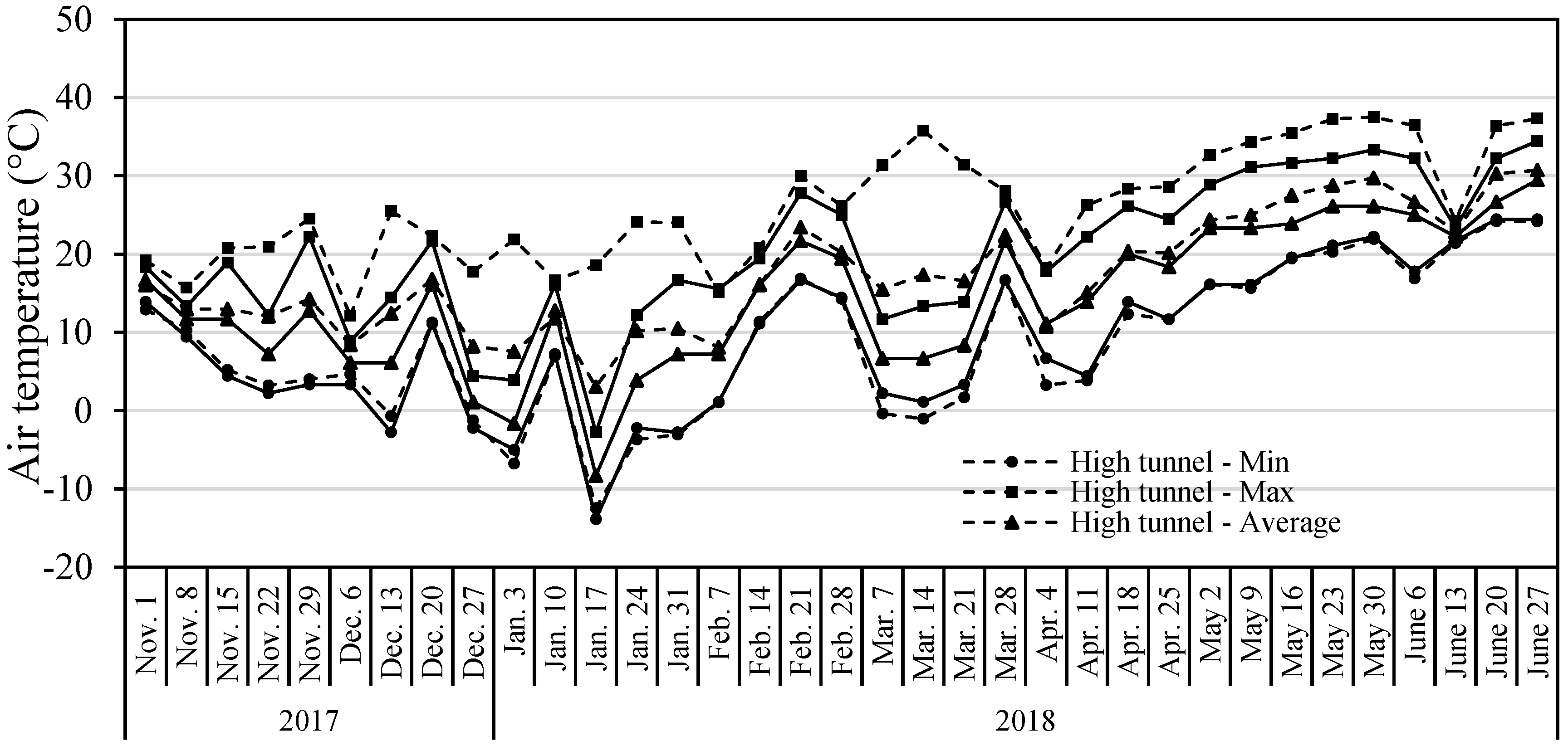
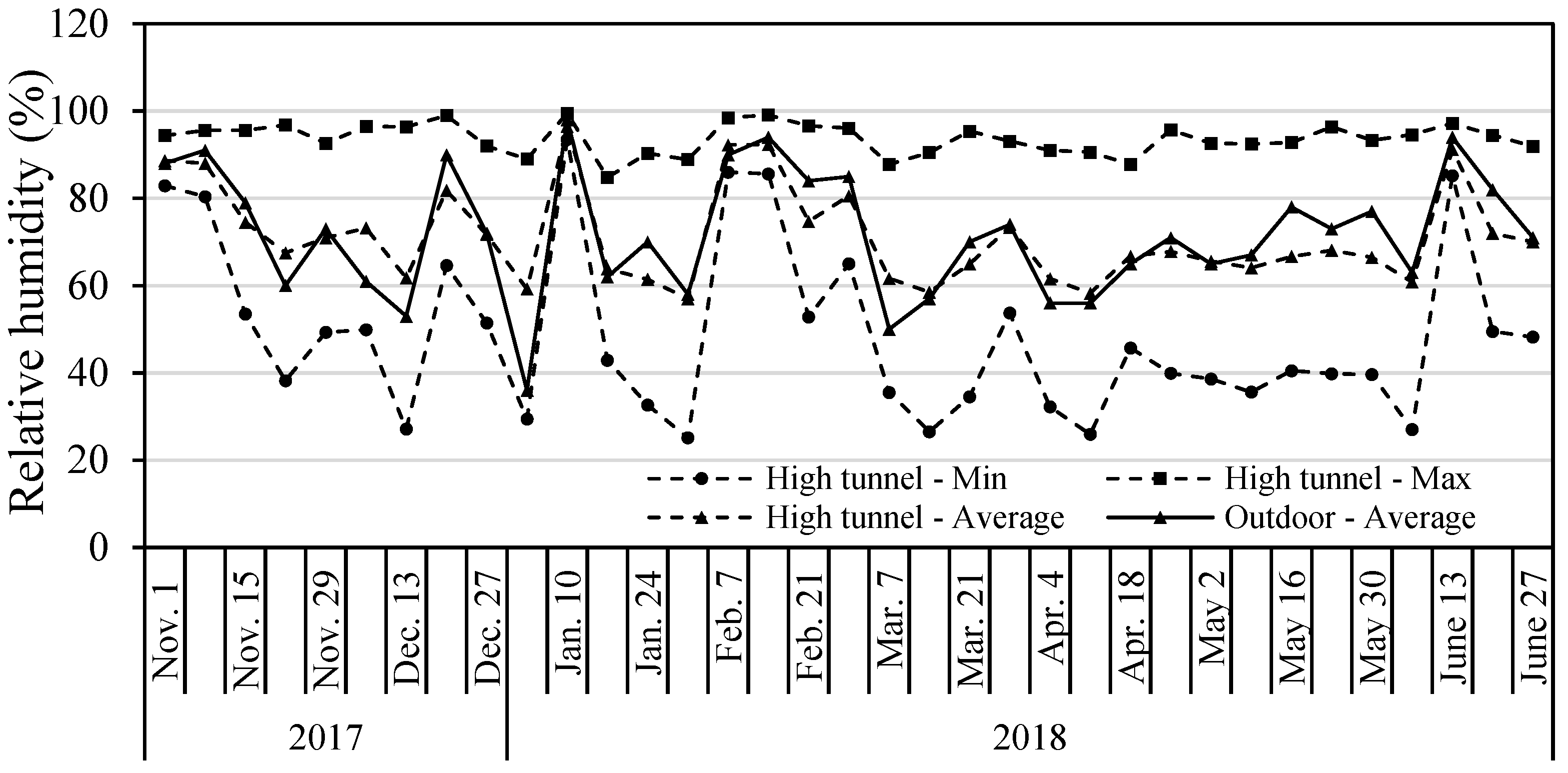
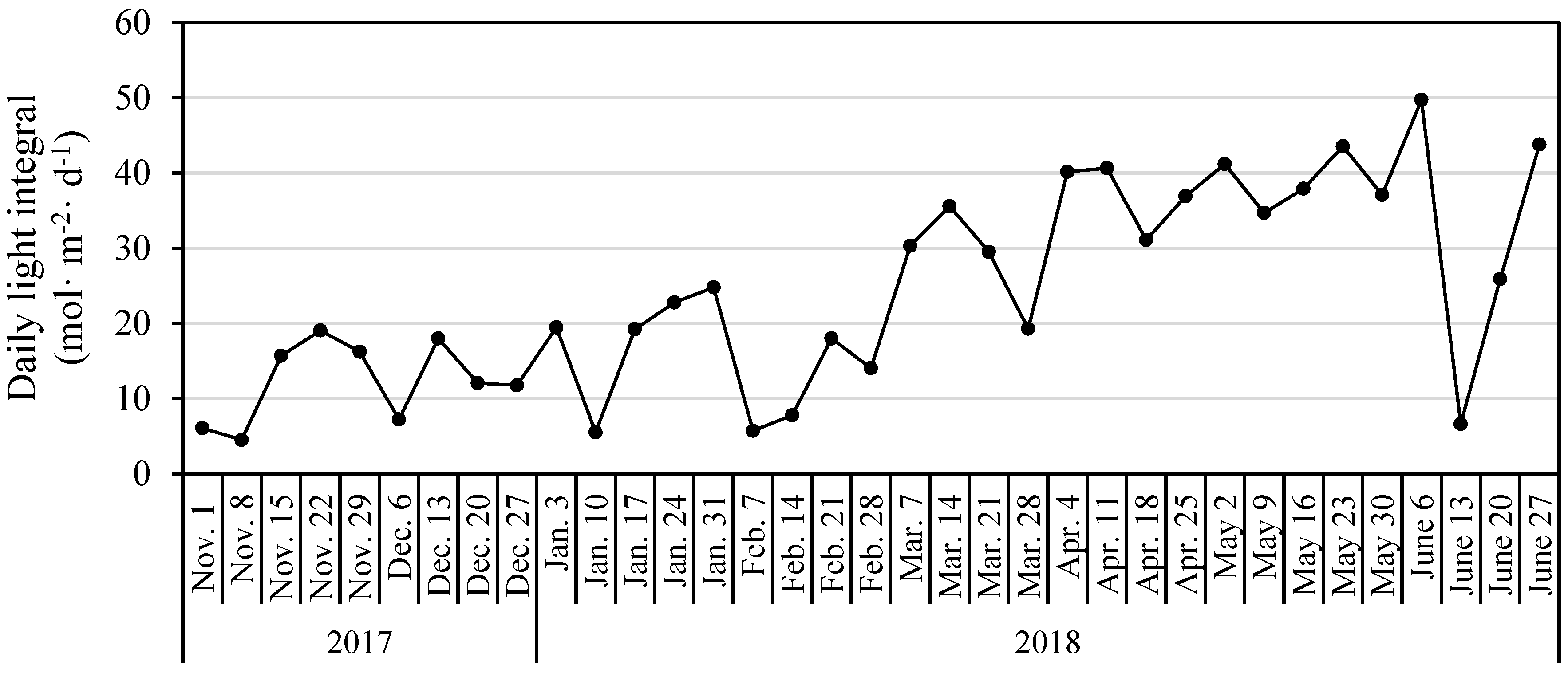
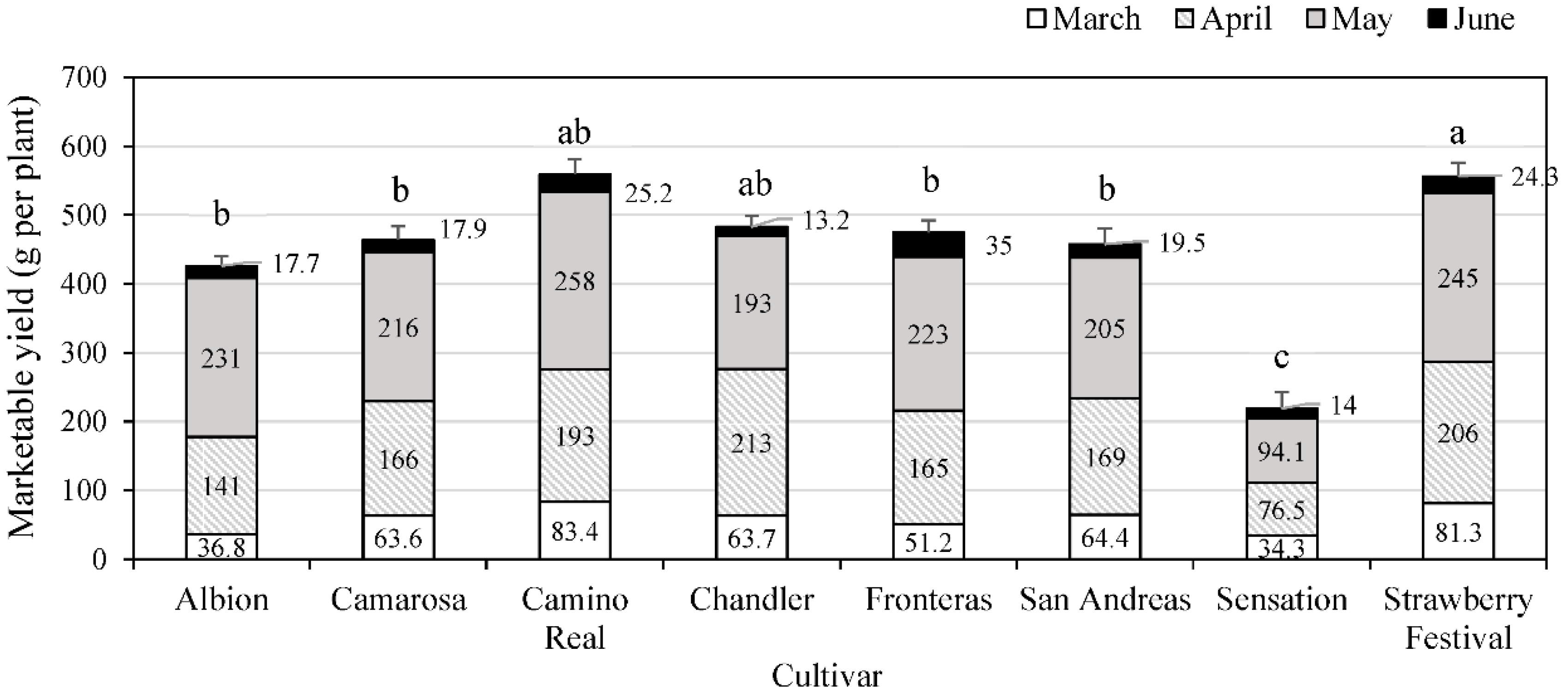

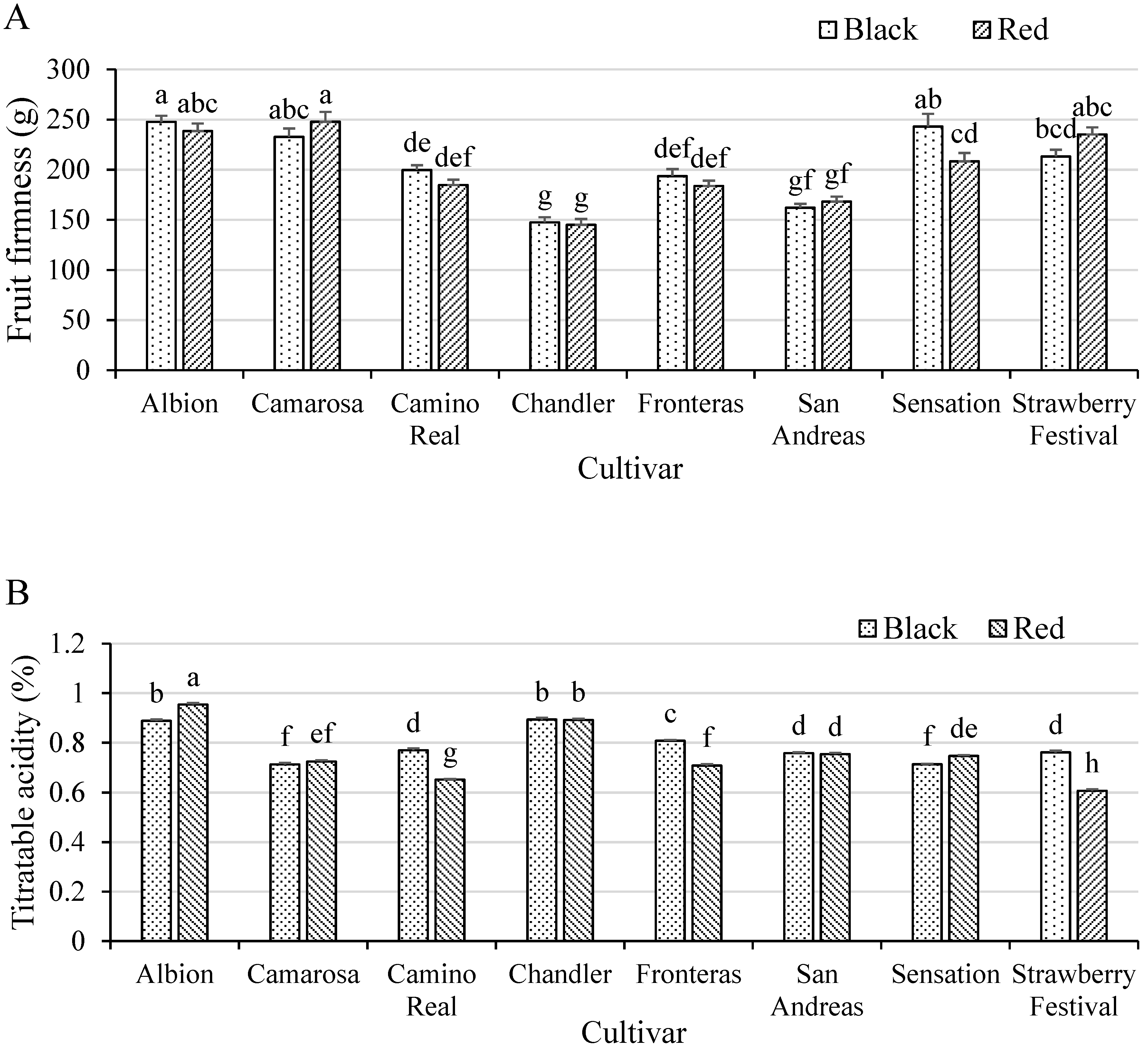
| Plant Vegetative Growth and Total Yields z | ||||||||||
| PGI | SPAD | Number of Crowns | Fresh Shoot wt. | Dry Shoot wt. | Total Marketable Yield | Total Unmarketable Yield | ||||
| Effects | (cm) | (per Plant) | (g per Plant) | (g per Plant) | (g per Plant) | (g per Plant) | ||||
| p-value y | ||||||||||
| Cultivar | <0.0001 | <0.0001 | 0.0026 | 0.0079 | 0.0077 | <0.0001 | <0.0001 | |||
| Mulch | 0.87 | 0.99 | 0.45 | 0.28 | 0.14 | 0.67 | 0.12 | |||
| Cultivar × Mulch | 0.059 | 0.11 | 0.45 | 0.12 | 0.20 | 0.11 | 0.0002 | |||
| Strawberry Fruit Quality | ||||||||||
| Single-Berry wt. | Fruit Firmness | Soluble Solid Content | Titratable acidity | Total Phenolic Content z | Total Anthocyanin Content | |||||
| Effects | (g per berry) | (g) | (°Brix) | (%) | (mg GAE·L−1) | (mg Pg-3-glc equivalent·L−1) | ||||
| p-value | ||||||||||
| Cultivar | <0.0001 | <0.0001 | <0.0001 | <0.0001 | <0.0001 | <0.0001 | ||||
| Mulch | 0.57 | 0.30 | 0.25 | <0.0001 | 0.15 | 0.31 | ||||
| Cultivar × Mulch | 0.29 | 0.0007 | 0.22 | <0.0001 | 0.44 | 0.45 | ||||
| Cultivar | PGI z | SPAD | Number of Crowns | Fresh Shoot wt. | Dry Shoot wt. |
|---|---|---|---|---|---|
| (cm) | (per Plant) | (g per Plant) | (g per Plant) | ||
| Albion | 29.9 c | 42.9 a | 3.5 b | 72.7 b | 27.3 b |
| Camarosa | 32.8 abc | 40.9 a | 4.8 ab | 101.7 ab | 39.3 ab |
| Camino Real | 31.0 bc | 43.0 a | 5.3 a | 100.7 ab | 38.6 ab |
| Chandler | 33.0 abc | 37.2 b | 5.4 a | 95.2 ab | 37.1 ab |
| Fronteras | 33.5 ab | 42.8 a | 4.8 ab | 92.3 b | 31.5 ab |
| San Andreas | 34.7 a | 42.5 a | 4.0 ab | 106.9 ab | 39.6 ab |
| Sensation | 32.7 abc | 38.0 b | 4.8 ab | 107.6 ab | 32.1 ab |
| Strawberry Festival | 34.4 ab | 38.5 b | 4.8 ab | 129.6 a | 44.3 a |
| p-value y | 0.0005 | <0.0001 | 0.0026 | 0.0079 | 0.0077 |
| Cultivar | Mulch | Date of First Ripe Fruit in March 2018 | DAT (d) | Cumulative GDDs from Planting z |
|---|---|---|---|---|
| Albion | Black | 9th | 111 | 1312 |
| Red | 14th | 116 | 1374 | |
| Camarosa | Black | 4th | 106 | 1249 |
| Red | 12th | 114 | 1346 | |
| Camino Real | Black | 13th | 115 | 1361 |
| Red | 13th | 115 | 1361 | |
| Chandler | Black | 7th | 109 | 1289 |
| Red | 13th | 115 | 1361 | |
| Fronteras | Black | 6th | 108 | 1279 |
| Red | 6th | 108 | 1279 | |
| San Andreas | Black | 12th | 114 | 1346 |
| Red | 7th | 109 | 1289 | |
| Sensation | Black | 7th | 109 | 1289 |
| Red | 14th | 116 | 1374 | |
| Strawberry Festival | Black | 8th | 110 | 1301 |
| Red | 7th | 109 | 1289 |
| Marketable Yield (g per Plant) z | Unmarketable Yield (g per Plant) | |||
|---|---|---|---|---|
| Mulch | March | May | March | May |
| Black | 63.7 | 202 | 0.7 | 5.3 |
| Red | 57.2 | 220 | 1.3 | 7.5 |
| p-value y | 0.03 | 0.018 | 0.018 | 0.037 |
| Single-Berry wt z | Soluble Solids Content | Total Phenolic Content y | Total Anthocyanin Content | |
|---|---|---|---|---|
| (g per Berry) | (°Brix) | (mg GAE·L−1) | (mg Pg-3-glc Equivalent·L−1) | |
| Albion | 24.0 a | 10.0 a | 582 bc | 129 cd |
| Camarosa | 17.2 bc | 8.1 cd | 604 a | 196 ab |
| Camino Real | 17.1 bc | 7.5 d | 576 bc | 202 a |
| Chandler | 16.3 c | 9.1 b | 594 ab | 160 bc |
| Fronteras | 21.9 ab | 8.4 c | 594 ab | 110 d |
| San Andreas | 19.7 abc | 8.7 bc | 572 c | 110 d |
| Sensation | 19.3 abc | 9.9 a | 583 bc | 109 d |
| Strawberry Festival | 15.6 c | 9.1 b | 582 bc | 134 cd |
| p-value x | <0.0001 | <0.0001 | <0.0001 | <0.0001 |
Publisher’s Note: MDPI stays neutral with regard to jurisdictional claims in published maps and institutional affiliations. |
© 2020 by the authors. Licensee MDPI, Basel, Switzerland. This article is an open access article distributed under the terms and conditions of the Creative Commons Attribution (CC BY) license (http://creativecommons.org/licenses/by/4.0/).
Share and Cite
Lalk, G.T.; Bi, G.; Zhang, Q.; Harkess, R.L.; Li, T. High-Tunnel Production of Strawberries Using Black and Red Plastic Mulches. Horticulturae 2020, 6, 73. https://doi.org/10.3390/horticulturae6040073
Lalk GT, Bi G, Zhang Q, Harkess RL, Li T. High-Tunnel Production of Strawberries Using Black and Red Plastic Mulches. Horticulturae. 2020; 6(4):73. https://doi.org/10.3390/horticulturae6040073
Chicago/Turabian StyleLalk, Geoffrey T., Guihong Bi, Qianwen Zhang, Richard L. Harkess, and Tongyin Li. 2020. "High-Tunnel Production of Strawberries Using Black and Red Plastic Mulches" Horticulturae 6, no. 4: 73. https://doi.org/10.3390/horticulturae6040073
APA StyleLalk, G. T., Bi, G., Zhang, Q., Harkess, R. L., & Li, T. (2020). High-Tunnel Production of Strawberries Using Black and Red Plastic Mulches. Horticulturae, 6(4), 73. https://doi.org/10.3390/horticulturae6040073






